Abstract
Highly purified human third component of complement (C3) was used to coat sheep erythrocytes (E) that were sensitized with IgM antibody (EA), forming EAC3b over a wide range of C3 molecules per cell. EAC3b were converted to EAC3bi by incubation with purified C3b inactivator (factor I) and beta 1H globulin (factor H). EAC3bi were in turn trypsinized to produce the cellular intermediate EAC3d. Each of the cell types was carefully characterized to be certain of the type of C3 determinant expressed. These cellular complement intermediates were used to assess by rosette formation the C3 receptor activity on peripheral blood monocytes under various experimental conditions. Uncultivated monocytes from peripheral blood bound EAC3b and EAC3bi well but did not bind EAC3d significantly. However, upon cultivation on glass surfaces in the presence of fetal calf serum but not bovine serum albumin, monocytes showed a progressive increase in expression of the C3d receptor. The Fab' fragment of anti-C3c blocked binding of EAC3b completely, blocked EAC3bi partially, but failed to block binding of EAC3d to cultivated monocytes. In contrast, the Fab' fragment of anti-C3d blocked EAC3d rosette formation completely. These studies demonstrate that monocytes are capable of expressing receptor activity for a determinant on C3d but that the expression of this receptor depends on the state of activation or differentiation of the cells.
Full text
PDF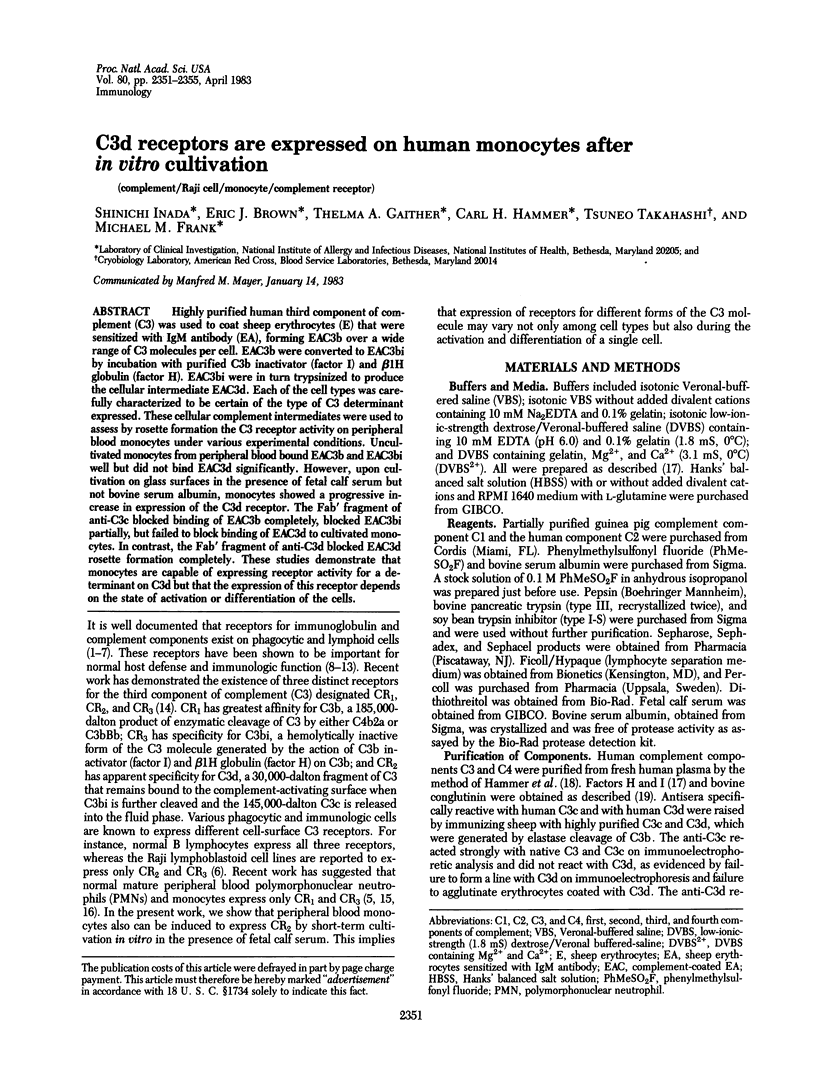
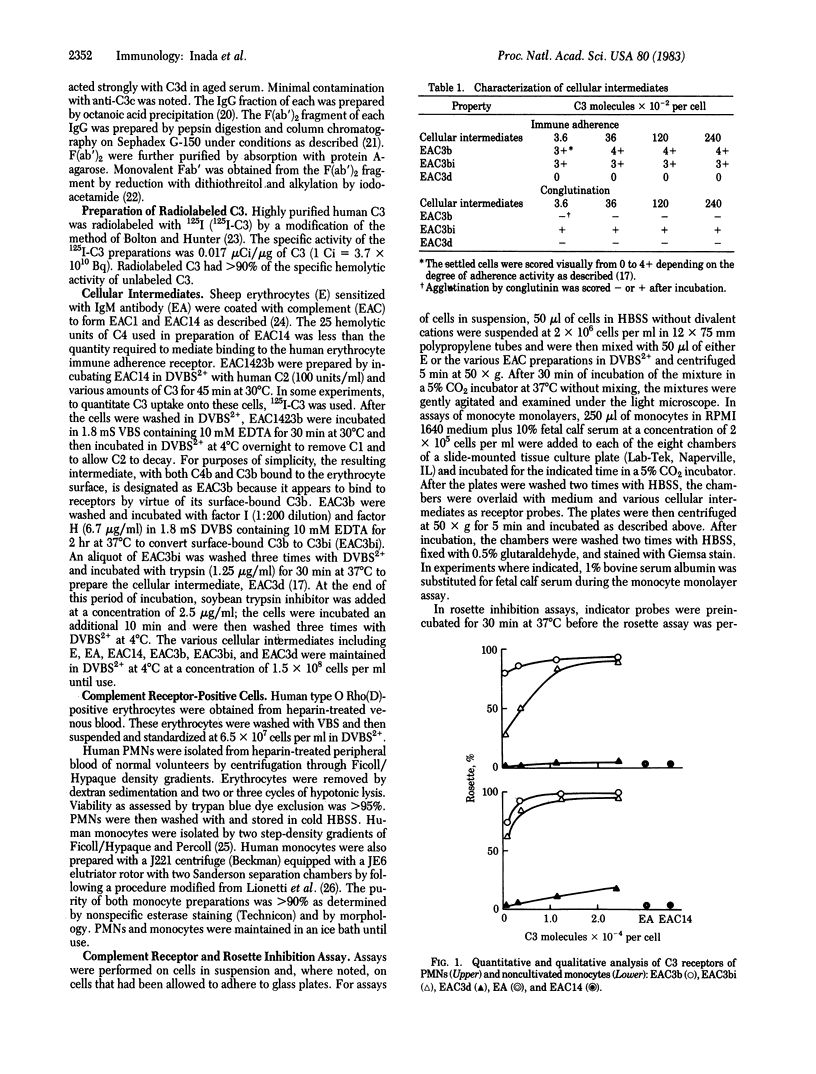
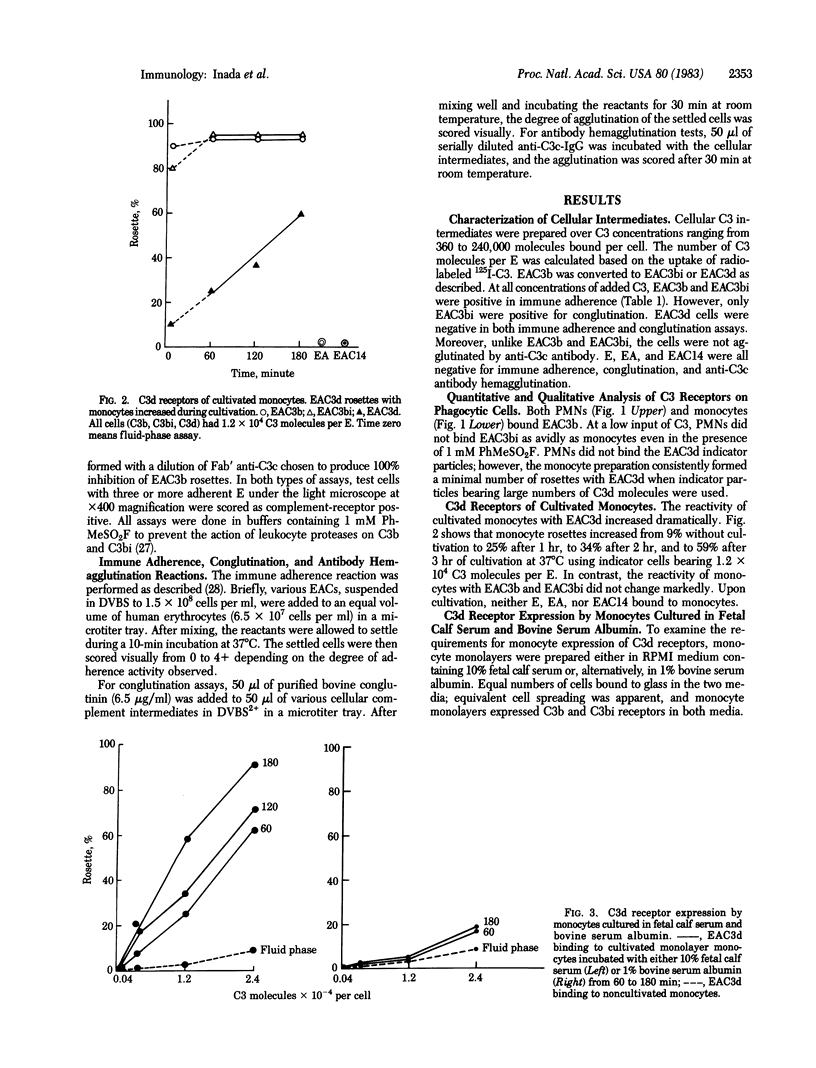
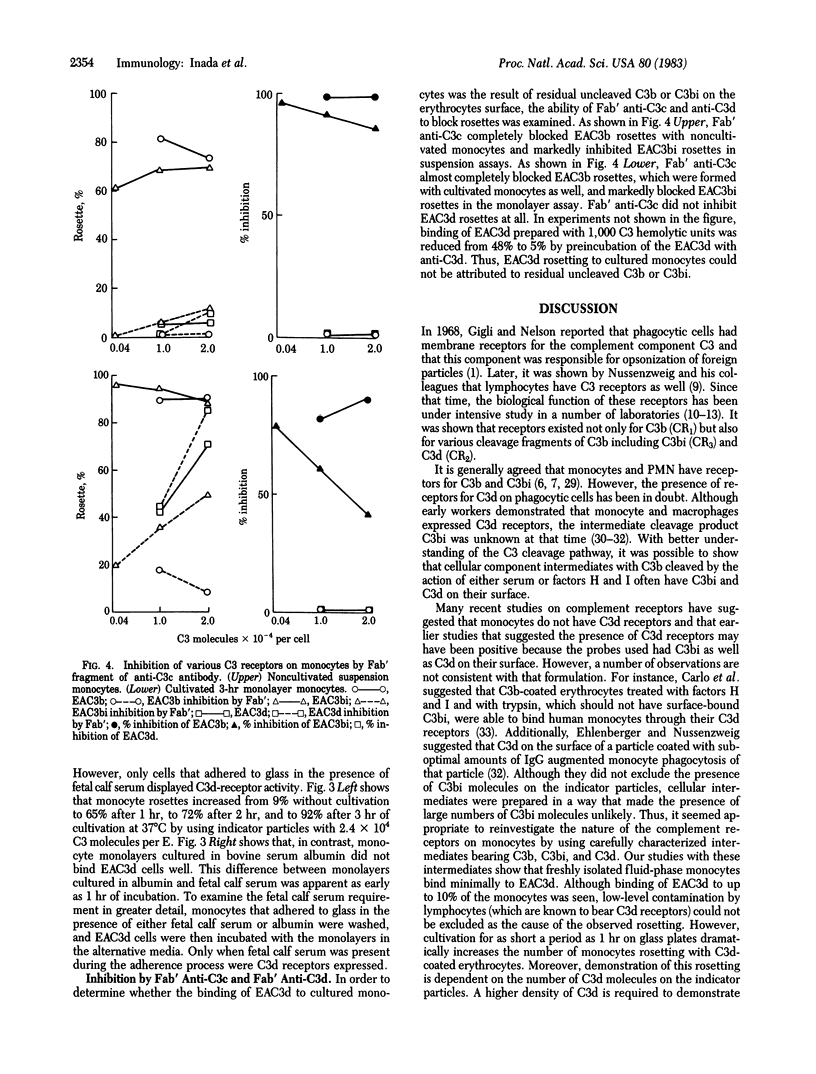
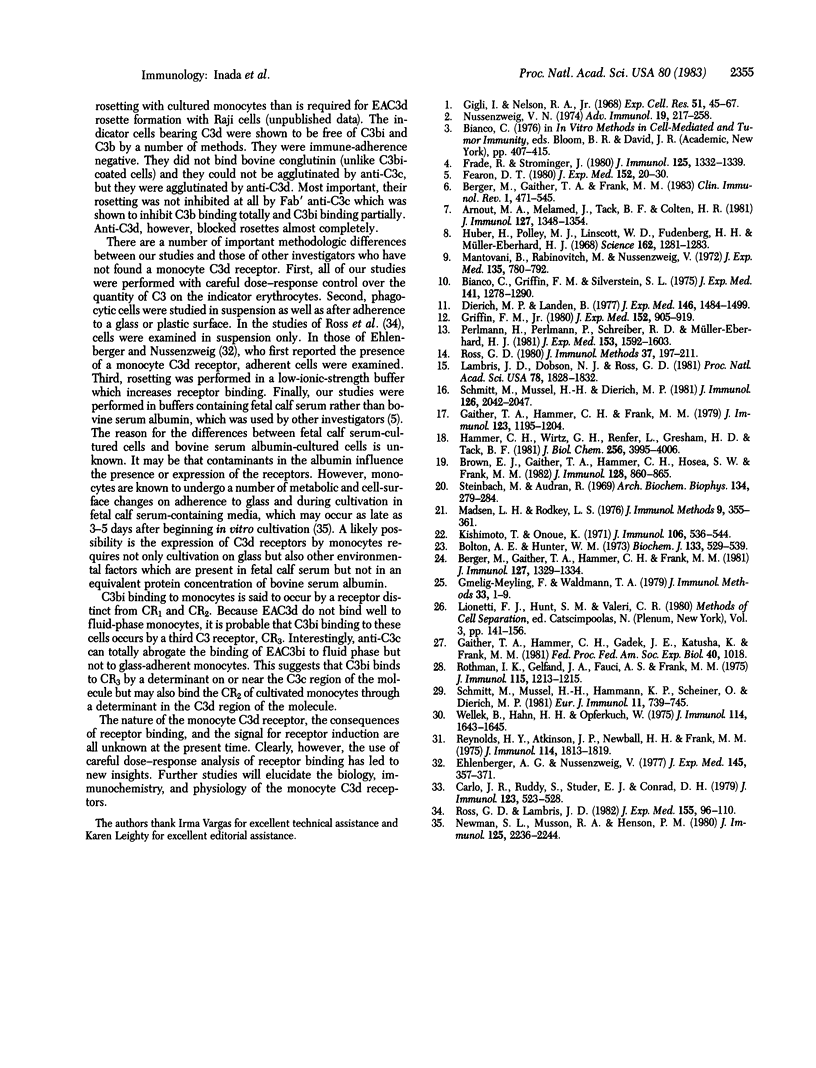
Selected References
These references are in PubMed. This may not be the complete list of references from this article.
- Arnaout M. A., Melamed J., Tack B. F., Colten H. R. Characterization of the human complement (c3b) receptor with a fluid phase C3b dimer. J Immunol. 1981 Oct;127(4):1348–1354. [PubMed] [Google Scholar]
- Berger M., Gaither I. A., Frank M. M. Complement receptors. Clin Immunol Rev. 1981;1(4):471–545. [PubMed] [Google Scholar]
- Berger M., Gaither T. A., Hammer C. H., Frank M. M. Lack of binding of human C3, in its native state, to C3b receptors. J Immunol. 1981 Oct;127(4):1329–1334. [PubMed] [Google Scholar]
- Bianco C., Griffin F. M., Jr, Silverstein S. C. Studies of the macrophage complement receptor. Alteration of receptor function upon macrophage activation. J Exp Med. 1975 Jun 1;141(6):1278–1290. doi: 10.1084/jem.141.6.1278. [DOI] [PMC free article] [PubMed] [Google Scholar]
- Bolton A. E., Hunter W. M. The labelling of proteins to high specific radioactivities by conjugation to a 125I-containing acylating agent. Biochem J. 1973 Jul;133(3):529–539. doi: 10.1042/bj1330529. [DOI] [PMC free article] [PubMed] [Google Scholar]
- Brown E. J., Gaither T. A., Hammer C. H., Hosea S. W., Frank M. M. The use of conglutinin in a quantitative assay for the presence of cell-bound C3bi and evidence that a single molecule of C3bi is capable of binding conglutinin. J Immunol. 1982 Feb;128(2):860–865. [PubMed] [Google Scholar]
- Carlo J. R., Ruddy S., Studer E. J., Conrad D. H. Complement receptor binding of C3b-coated cells treated with C3b inactivator, beta 1H globulin and trypsin. J Immunol. 1979 Aug;123(2):523–528. [PubMed] [Google Scholar]
- Dierich M. P., Landen B. Complement bridges between cells analysis of a possible cell-cell interaction mechanism. J Exp Med. 1977 Dec 1;146(6):1484–1499. doi: 10.1084/jem.146.6.1484. [DOI] [PMC free article] [PubMed] [Google Scholar]
- Ehlenberger A. G., Nussenzweig V. The role of membrane receptors for C3b and C3d in phagocytosis. J Exp Med. 1977 Feb 1;145(2):357–371. doi: 10.1084/jem.145.2.357. [DOI] [PMC free article] [PubMed] [Google Scholar]
- Fearon D. T. Identification of the membrane glycoprotein that is the C3b receptor of the human erythrocyte, polymorphonuclear leukocyte, B lymphocyte, and monocyte. J Exp Med. 1980 Jul 1;152(1):20–30. doi: 10.1084/jem.152.1.20. [DOI] [PMC free article] [PubMed] [Google Scholar]
- Frade R., Strominger J. Binding of soluble 125I-human C3b, the third component of complement, to specific receptors in human cultured B lymphoblastoids cells: characterization of a low affinity interaction. J Immunol. 1980 Sep;125(3):1332–1339. [PubMed] [Google Scholar]
- Gaither T. A., Hammer C. H., Frank M. M. Studies of the molecular mechanisms of C3b inactivation and a simplified assay of beta 1H and the C3b inactivator (C3bINA). J Immunol. 1979 Sep;123(3):1195–1204. [PubMed] [Google Scholar]
- Gigli I., Nelson R. A., Jr Complement dependent immune phagocytosis. I. Requirements for C'1, C'4, C'2, C'3. Exp Cell Res. 1968 Jul;51(1):45–67. doi: 10.1016/0014-4827(68)90158-4. [DOI] [PubMed] [Google Scholar]
- Gmelig-Meyling F., Waldmann T. A. Separation of human blood monocytes and lymphocytes on a continuous Percoll gradient. J Immunol Methods. 1980;33(1):1–9. doi: 10.1016/0022-1759(80)90077-0. [DOI] [PubMed] [Google Scholar]
- Griffin F. M., Jr Effects of soluble immune complexes on Fc receptor- and C3b receptor-mediated phagocytosis by macrophages. J Exp Med. 1980 Oct 1;152(4):905–919. doi: 10.1084/jem.152.4.905. [DOI] [PMC free article] [PubMed] [Google Scholar]
- Hammer C. H., Wirtz G. H., Renfer L., Gresham H. D., Tack B. F. Large scale isolation of functionally active components of the human complement system. J Biol Chem. 1981 Apr 25;256(8):3995–4006. [PubMed] [Google Scholar]
- Huber H., Polley M. J., Linscott W. D., Fudenberg H. H., Müller-Eberhard H. J. Human monocytes: distinct receptor sites for the third component of complement and for immunoglobulin G. Science. 1968 Dec 13;162(3859):1281–1283. doi: 10.1126/science.162.3859.1281. [DOI] [PubMed] [Google Scholar]
- Kishimoto T., Onoue K. Agglutinating activities of pepsin fragments and subunits of IgM antibodies. J Immunol. 1971 Feb;106(2):536–544. [PubMed] [Google Scholar]
- Lambris J. D., Dobson N. J., Ross G. D. Isolation of lymphocyte membrane complement receptor type two (the C3d receptor) and preparation of receptor-specific antibody. Proc Natl Acad Sci U S A. 1981 Mar;78(3):1828–1832. doi: 10.1073/pnas.78.3.1828. [DOI] [PMC free article] [PubMed] [Google Scholar]
- Madsen L. H., Rodkey L. S. A method for preparing IgG F(ab')2 fragments using small amounts of serum. J Immunol Methods. 1976;9(3-4):355–361. doi: 10.1016/0022-1759(76)90210-6. [DOI] [PubMed] [Google Scholar]
- Mantovani B., Rabinovitch M., Nussenzweig V. Phagocytosis of immune complexes by macrophages. Different roles of the macrophage receptor sites for complement (C3) and for immunoglobulin (IgG). J Exp Med. 1972 Apr 1;135(4):780–792. doi: 10.1084/jem.135.4.780. [DOI] [PMC free article] [PubMed] [Google Scholar]
- Newman S. L., Musson R. A., Henson P. M. Development of functional complement receptors during in vitro maturation of human monocytes into macrophages. J Immunol. 1980 Nov;125(5):2236–2244. [PubMed] [Google Scholar]
- Nussenzweig V. Receptors for immune complexes on lymphocytes. Adv Immunol. 1974;19(0):217–258. doi: 10.1016/s0065-2776(08)60253-9. [DOI] [PubMed] [Google Scholar]
- Perlmann H., Perlmann P., Schreiber R. D., Müller-Eberhard H. J. Interaction of target cell-bound C3bi and C3d with human lymphocyte receptors. Enhancement of antibody-mediated cellular cytotoxicity. J Exp Med. 1981 Jun 1;153(6):1592–1603. doi: 10.1084/jem.153.6.1592. [DOI] [PMC free article] [PubMed] [Google Scholar]
- Reynolds H. Y., Atkinson J. P., Newball H. H., Frank M. M. Receptors for immunoglobulin and complement on human alveolar macrophages. J Immunol. 1975 Jun;114(6):1813–1819. [PubMed] [Google Scholar]
- Ross G. D. Analysis of the different types of leukocyte membrane complement receptors and their interaction with the complement system. J Immunol Methods. 1980;37(3-4):197–211. doi: 10.1016/0022-1759(80)90307-5. [DOI] [PubMed] [Google Scholar]
- Ross G. D., Lambris J. D. Identification of a C3bi-specific membrane complement receptor that is expressed on lymphocytes, monocytes, neutrophils, and erythrocytes. J Exp Med. 1982 Jan 1;155(1):96–110. doi: 10.1084/jem.155.1.96. [DOI] [PMC free article] [PubMed] [Google Scholar]
- Schmitt M., Mussel H. H., Dierich M. P. Qualitative and quantitative assessment of C3-receptor reactivities on lymphoid and phagocytic cells. J Immunol. 1981 May;126(5):2042–2047. [PubMed] [Google Scholar]
- Schmitt M., Mussel H. H., Hammann K. P., Scheiner O., Dierich M. P. Role of beta 1H for the binding of C3b-coated particles to human lymphoid and phagocytic cells. Eur J Immunol. 1981 Oct;11(10):739–745. doi: 10.1002/eji.1830111002. [DOI] [PubMed] [Google Scholar]
- Steinbuch M., Audran R. The isolation of IgG from mammalian sera with the aid of caprylic acid. Arch Biochem Biophys. 1969 Nov;134(2):279–284. doi: 10.1016/0003-9861(69)90285-9. [DOI] [PubMed] [Google Scholar]
- Wellek B., Hahn H. H., Opferkuch W. Evidence for macrophage C3d-receptor active in phagocytosis. J Immunol. 1975 May;114(5):1643–1645. [PubMed] [Google Scholar]


